Weaving hypothesis of cardiomyocyte sarcomeres: discovery of periodic broadening and narrowing of intercalated disk during volume-load change
- PMID: 20056839
- PMCID: PMC2808074
- DOI: 10.2353/ajpath.2010.090348
Weaving hypothesis of cardiomyocyte sarcomeres: discovery of periodic broadening and narrowing of intercalated disk during volume-load change
Abstract
To investigate how cardiomyocytes change their length, echocardiographic and morphological studies were performed on rabbit hearts that were subjected to volume overload, overload removal, and repeated cycles of overload and overload removal. These conditions were created by arterio-venous fistula between the carotid artery and jugular vein, closure of the fistula, and cycles of repeatedly forming and closing fistula, respectively. After overload, hearts dilated and myocytes elongated. Intercalated disks repeatedly broadened and narrowed with a 2-day cycle, which continued for 8 weeks in many animals. The cycle consisted of shifts between five modes characterized by two interdigitation elongation-and-shortenings as follows: (I) flat with short ( approximately 1/4 to approximately 1/3 sarcomere long) interdigitations; (II) flat with long (one sarcomere long) interdigitations; (III) grooved with short interdigitations; (IV) grooved with long interdigitations; (V) flat with short interdigitations intermingled by sporadic long interdigitations; and return to (I). After overload removal, hearts contracted and myocytes shortened with similar 2-day broadening and narrowing cycle of intercalated disks, in which the five modes were reversed. Repeated overload and overload removal resulted in the repetition of myocyte elongation and shortening. We hypothesize that a single elongation-and-shortening event creates or disposes one sarcomere layer, and the two consecutive elongation-and-shortenings occur complementarily to each other so that the disks return to their original state after each cycle. Our hypothesis predicts that intercalated disks weave and unravel one sarcomere per myocyte per day.
Figures




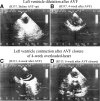

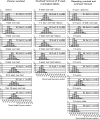
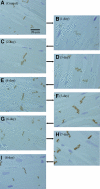
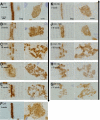
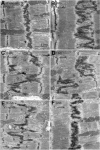
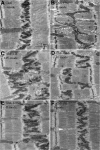

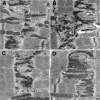


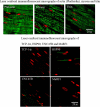


Similar articles
-
Unravelling the ultrastructural details of αT-catenin-deficient cell-cell contacts between heart muscle cells by the use of FIB-SEM.J Microsc. 2020 Sep;279(3):189-196. doi: 10.1111/jmi.12855. Epub 2019 Dec 22. J Microsc. 2020. PMID: 31828778
-
Right ventricular remodeling in response to volume overload in fetal sheep.Am J Physiol Heart Circ Physiol. 2019 May 1;316(5):H985-H991. doi: 10.1152/ajpheart.00439.2018. Epub 2019 Feb 1. Am J Physiol Heart Circ Physiol. 2019. PMID: 30707615 Free PMC article.
-
Real-time measurement of the length of a single sarcomere in rat ventricular myocytes: a novel analysis with quantum dots.Am J Physiol Cell Physiol. 2011 Nov;301(5):C1116-27. doi: 10.1152/ajpcell.00161.2011. Epub 2011 Aug 3. Am J Physiol Cell Physiol. 2011. PMID: 21813712
-
Role of sarcomere mechanics and Ca2+ overload in Ca2+ waves and arrhythmias in rat cardiac muscle.Ann N Y Acad Sci. 2006 Oct;1080:248-67. doi: 10.1196/annals.1380.020. Ann N Y Acad Sci. 2006. PMID: 17132788 Review.
-
Cytoarchitecture and intercalated disks of the working myocardium and the conduction system in the mammalian heart.Anat Rec A Discov Mol Cell Evol Biol. 2004 Oct;280(2):940-51. doi: 10.1002/ar.a.20109. Anat Rec A Discov Mol Cell Evol Biol. 2004. PMID: 15368339 Review.
Cited by
-
Riding the waves of the intercalated disc of the heart.Biophys Rev. 2018 Aug;10(4):955-959. doi: 10.1007/s12551-018-0438-z. Epub 2018 Jul 9. Biophys Rev. 2018. PMID: 29987752 Free PMC article. Review.
-
Growth and remodeling of the left ventricle: A case study of myocardial infarction and surgical ventricular restoration.Mech Res Commun. 2012 Jun 1;42:134-141. doi: 10.1016/j.mechrescom.2012.03.005. Epub 2012 Mar 12. Mech Res Commun. 2012. PMID: 22778489 Free PMC article.
-
Xin proteins and intercalated disc maturation, signaling and diseases.Front Biosci (Landmark Ed). 2012 Jun 1;17(7):2566-93. doi: 10.2741/4072. Front Biosci (Landmark Ed). 2012. PMID: 22652799 Free PMC article. Review.
-
Sarcoplasmic reticulum is an intermediary of mitochondrial and myofibrillar growth at the intercalated disc.J Muscle Res Cell Motil. 2016 Jun;37(3):55-69. doi: 10.1007/s10974-016-9444-6. Epub 2016 Jun 21. J Muscle Res Cell Motil. 2016. PMID: 27329158 Free PMC article.
-
Disorganization of intercalated discs in dilated cardiomyopathy.Sci Rep. 2021 Jun 4;11(1):11852. doi: 10.1038/s41598-021-90502-1. Sci Rep. 2021. PMID: 34088908 Free PMC article.
References
-
- Linzbach AJ. Heart failure from the point of view of quantitative anatomy. Am J Cardiol. 1960;5:370–382. - PubMed
-
- Ross J., Jr Adaptations of the left ventricle to chronic volume overload. Circ Res. 1974;35 suppl II:64–70. - PubMed
-
- Hunter JJ, Chien KR. Signaling pathways for cardiac hypertrophy and failure. New Eng J Med. 1999;341:1276–1283. - PubMed
-
- Gerdes AM, Campbell SE, Hilbelink DR. Structural remodeling of cardiac myocytes in rats with arteriovenous fistulas. Lab Invest. 1988;59:857–861. - PubMed
-
- Huang M, Hester RL, Guyton AC. Hemodynamic changes in rats after opening an arteriovenous fistula. Am J Physiol. 1992;262:H846–H851. - PubMed
Publication types
MeSH terms
LinkOut - more resources
Full Text Sources

